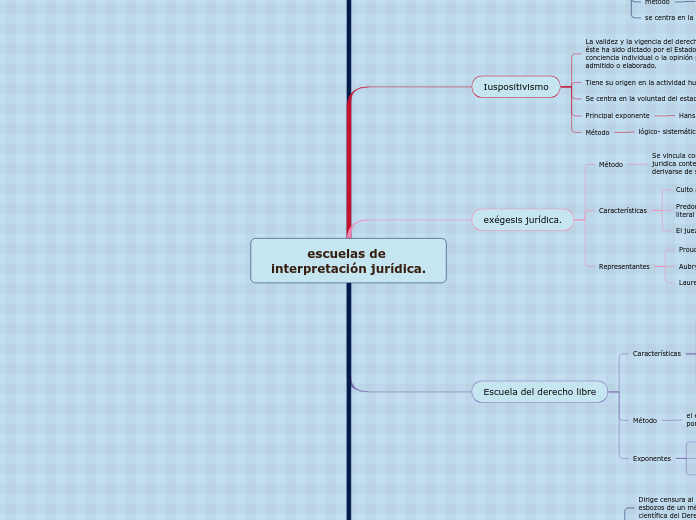escuelas de interpretación jurídica.
To name your story, you have to think about the overall message and what you want your audience to understand from the story. Also, make it relevant and easy to remember.
Escuela científica francesa
Se utilizan dos clases de procedimientos para construir el Derecho, procedimientos técnicos formales y procedimientos técnicos intelectuales
(conceptualización, abstracción y sistematización).
Francois Geny
El Dato y lo construido son sus aportaciones
metodológicas.
La parte científica esta contenida en lo que llama Dato y en lo construido.
Geny considera necesario aportar la parte científica de la interpretación del derecho
Dirige censura al método exegético; y presenta esbozos de un método de libre investigación científica del Derecho
Escuela del derecho libre
The ending of a story is essential. We all know that if the ending is weak, what happened before loses its importance. So make it unpredictable, but fair. A resolved ending answers all the questions and ties up any loose threads from the plot.
Exponentes
O Bülow
Hermann Kantorowicz
Planiol
This is the closure section of the story.
See examples of possible outcomes below:
- all problems have been solved
- it's clear how each one of your characters ends up
- your main character is transformed by the challenge
el estudio de los hechos y auxiliados
por la lógica
Try answering these questions to come up with a closure:
- Have all the problems been solved?
- Is there a clear picture of what happens with each character in the story?
- Has the challenge transformed your main character?
- How do the characters feel in the end?
This is the moment when the main character surpasses the last obstacle and finally faces their greatest challenge.
The climax usually follows one of these patterns:
- realization
- resolution
- choice
Type in your answer.
Sostienen que el derecho no se limita a las normas dadas por el legislador, que el derecho estatal, las decisiones de los tribunales y el derecho consuetudinario no agotan todo el campo jurídico.
Rechaza la idea de que el derecho es únicamente el que emana del Estado al igual que la que postula que la ley es todo el derecho.
Afirman la existencia de un derecho diferente del estatal, algunos autores lo denomina el derecho de la sociedad o derecho social.
exégesis jurídica.
The middle of the story is where you add layers of complications that will lead to the end. Reveal more about the character's journey. Did their personality go through changes? How did they overcome the challenges? And as you build up the story’s central conflict, make it more personal to that character. Also, from the middle act, you have to lead into the final act.
Representantes
There wouldn't be any tension and excitement in your story if there weren't any obstacles in your character's way.
Laurent
Aubry rau
Proudhon
A story is nothing more than a character overcoming a series of difficulties to reach the desired goal. Obstacles usually create suspense and conflict. In overcoming obstacles, there is growth: weak becomes strong; hatred turns into love; sadness into happiness; wrong into right; lies into truth; or evil becomes good.
See a few examples below:
- stopping a meteor
- finding a killer
- finding love
Características
Your character(s) need(s) motivation in order to solve the challenge(s).
El juez es ciervo de la ley
Secondary characters also might have motivs beacuse of which they may cross path with main character or which might trigger them to help the main character.
Predominio a la intención del legislador el alcance literal de los textos legales
Secondary characters might also have motives that lead them to cross paths with the main character or which might trigger them to help the main character.
Culto al texto de la ley
Why does your character need to confront this challenge? What does he/she expect to accomplish by solving it?
See a few examples:
- will marry in 3 days
- can fix the mistakes of the past
Each story has a main character and that character usually needs to solve a problem or challenge. The character's challenge is the one that creates tension throughout the story.
Se vincula con el principio que postula que la norma juridica contempla todos los casos que puedan derivarse de su letra, de sus palabras.
In most stories, there are 3 challenges. The number 3 is a mystical number symbolizing completeness. Try to come up with interesting challenges with which your character needs to struggle.
See a few examples below:
- turns into a werewolf at night
- is sent back in time
Iuspositivismo
Método
lógico- sistemático
Principal exponente
Hans Kelsen
Se centra en la voluntad del estado
Tiene su origen en la actividad humana
La validez y la vigencia del derecho dependen de que
éste ha sido dictado por el Estado, y no porque la
conciencia individual o la opinión pública lo hayan
admitido o elaborado.
Escuela del derecho natural
In the beginning of the story (or the exposition), you will need to introduce the setting and characters. You might also want to introduce the main conflict. This part of the story is important because it gives the reader necessary background information and maybe even a first insight into a character’s personality.
se centra en la razón
método
filosófico racional-deductivo
identifica al derecho privado de tradicion romana con el derecho natural.
The setting (time & place) of a story can change throughout the plot.
surge la codificación.
se acerca mas al common law por las relaciones entre la corona y los particulares
principales exponentes
Characters are essential to a good story. Usually, the protagonist(s) is/are the most affected by the plot. Introduce a character by focusing on their actions, interests, and occupation, as the physical appearance doesn't make a difference in most cases.
domat
tomasio
grocio
altusio
Type in the name of your character.










